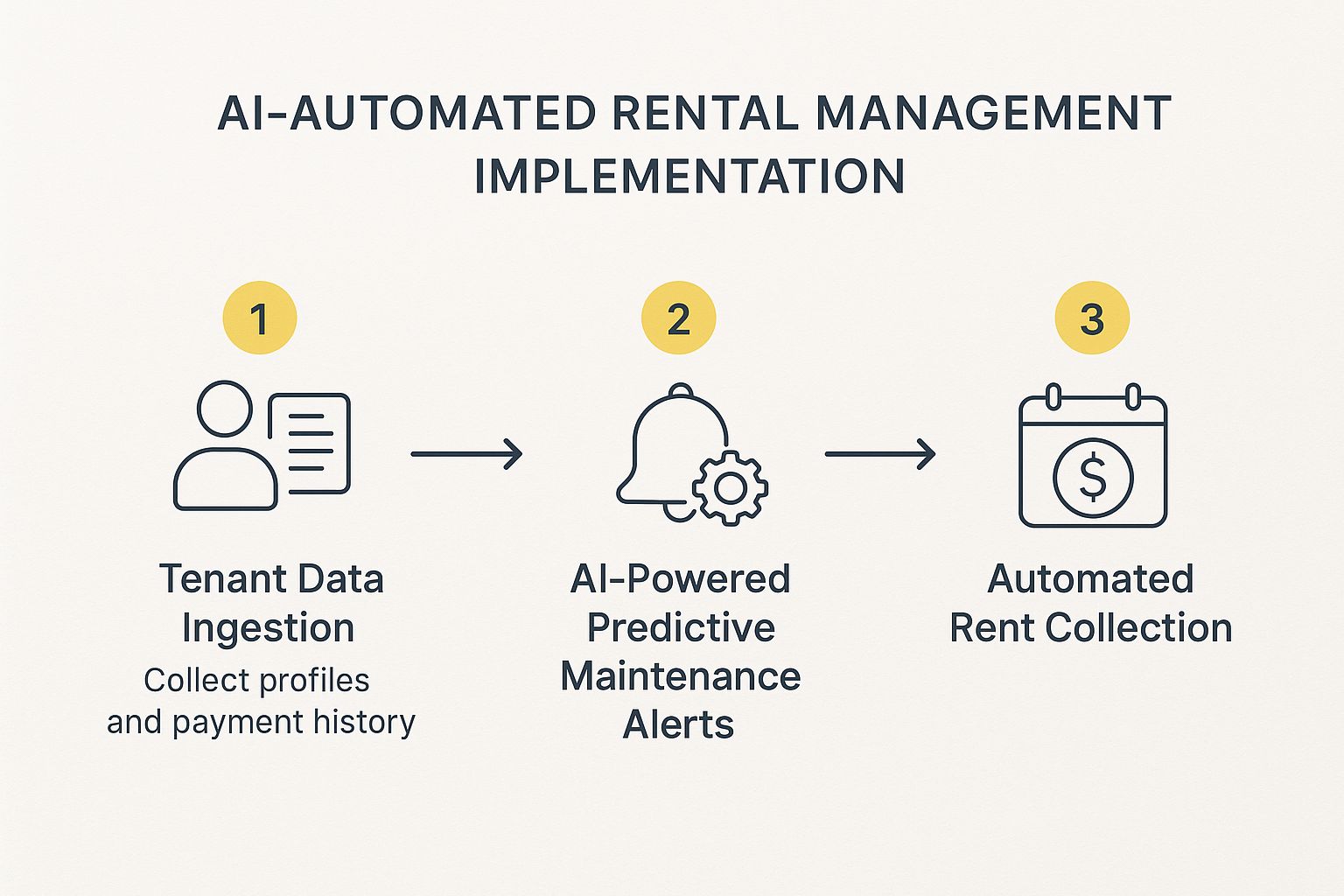Picture this: a property manager who’s on the clock 24/7, replies to tenant emails in a flash, and gives you a heads-up about a plumbing issue before it turns into a flood. That’s the reality of AI-automated rental management. It’s not about some wildly complex tech; it's about giving your property portfolio a super-efficient digital assistant.
So, What Exactly Is AI Rental Management?
At its heart, AI-automated rental management is all about using smart software to take care of the repetitive, time-sucking tasks that come with being a landlord. Think of it as the next big leap from keeping track of rent in a spreadsheet.
Instead of you manually chasing up late payments or sifting through a mountain of maintenance requests, this technology steps in and automates the whole process. This frees you up to focus on the bigger picture, like growing your investment.
This isn't about booting humans out of the equation. Far from it. It’s about making us better. The system handles the tedious admin, which means you can make smarter, faster decisions based on clear, well-organised data.
How Does It Actually Work?
This tech isn't a single, magical tool. It’s more like a team of features working together, applying clever algorithms to different parts of property management. For instance, an AI system can read a maintenance request from a tenant, figure out how urgent it is, and even suggest a qualified tradie from your list of approved contacts.
By taking over routine communications and admin duties, property managers are saving a massive amount of time. In fact, research shows that AI adoption in property management shot up from 21% in 2023 to 34% in 2024, which tells you just how quickly it’s becoming standard practice.
This automation covers pretty much the entire rental lifecycle. Some of the key functions you'll see include:
- Automated Tenant Communication: Getting back to common questions about rent, maintenance, or property rules instantly, any time of day or night.
- Predictive Maintenance Alerts: Using data from smart sensors to spot potential equipment failures before they happen, saving you from expensive emergency call-outs.
- Streamlined Leasing: Automatically advertising vacant properties and scheduling viewings to get new tenants in faster and slash those costly vacancy periods.
- Intelligent Financial Tracking: Sending out rent reminders, processing payments, and pulling together financial reports automatically, giving you a crystal-clear view of how your portfolio is performing.
Ultimately, AI-automated rental management turns what can often be a chaotic, reactive job into a proactive, smooth operation. For Australian landlords looking for a more efficient and profitable way to manage their properties, it’s quickly becoming an essential bit of kit.
The Core Technologies Driving Your Digital Landlord

To really get what makes AI-automated rental management tick, you need to look under the bonnet. It’s not a single piece of magic. It’s a suite of smart technologies working together to create a smooth experience for you and your tenants. Think of it like a well-oiled team where each member brings a vital skill to the table.
The core of this team is made up of a few key players. Each one takes raw data—like market trends, tenant messages, or property photos—and turns it into smart, automated actions.
Machine Learning: The Strategic Brain
At the centre of it all is Machine Learning (ML), which is basically the system's brain. ML algorithms sift through huge amounts of data to spot patterns and make predictions. It’s a lot like the "gut feeling" an experienced landlord develops over years, but this is based on pure data.
For example, ML can analyse current rental prices, vacancy rates, and what’s happening in the local area to suggest the perfect rent for your property. This makes sure you're pricing competitively to get tenants in quickly while still getting the best possible return on your investment.
Natural Language Processing: The Expert Communicator
Next up is Natural Language Processing (NLP), which acts as the system's ears and voice. NLP is what gives software the power to understand and respond to human language. So when a tenant sends a message saying, “The hot water isn’t working,” NLP gets the meaning and the urgency.
This is the tech that powers those automated responses and chatbots. In Australia, AI systems use NLP to offer 24/7 support, instantly answering questions about leases or maintenance, which makes a massive difference in efficiency for the rental sector.
A great real-world example is how AI chatbots in real estate have become a core driver for digital landlords. This is especially true when it comes to handling those late-night calls, where an AI answering service can manage tenant communications without needing a human to step in.
Because NLP understands context and sentiment, it can automatically categorise a maintenance request, ping the right tradesperson, and keep the tenant in the loop. This cuts response times from hours or even days down to just a few minutes.
Computer Vision: The Discerning Eye
Finally, you have Computer Vision, which gives the system its sense of sight. This technology can interpret and understand information from images and videos. The most common way you’ll see this in rental management is with those immersive virtual tours.
By letting potential tenants have a good look around a property from their own homes, computer vision helps attract a bigger pool of applicants. More importantly, it helps weed out those who aren't a good fit early on. It’s a simple but powerful tool that speeds up the leasing cycle and means your property spends less time sitting vacant.
Put them all together, and these technologies form the engine of your digital landlord, turning complex data into simple, effective property management.
How AI Is Reinventing Tenant Screening and Leasing

Finding the perfect tenant used to feel like a bit of a lucky dip, didn't it? A mix of gut feeling and hoping for the best. Today, AI-automated rental management is turning that gamble into a data-driven science, overhauling everything from how you list a property to the moment the lease is signed.
It all kicks off with smarter marketing. Instead of just casting a wide net and hoping for bites, AI tools dig into market data to help you write property descriptions that actually work. They pinpoint the features your ideal tenants are looking for and even suggest the best platforms to advertise on, making sure your listing lands in front of the right eyeballs.
Objective and Efficient Application Screening
Once the applications start rolling in, AI really begins to shine. We all know that sifting through applications manually is a slog. It’s slow, tedious, and—let's be honest—it can be easy for unconscious bias to creep in. An AI-powered system, on the other hand, can blitz through hundreds of applications with incredible speed and total objectivity.
The system applies the same consistent criteria to every single applicant, focusing only on the data that matters. This is a game-changer for ensuring fairness and staying compliant with fair housing laws.
- Data Extraction: AI scans application forms and documents like bank statements or reference letters, pulling out key information in an instant. No more manual data entry.
- Risk Highlighting: It can spot potential red flags that a human might miss, like gaps in employment or weird inconsistencies, and flag them for you to look at more closely.
- Automated Scoring: The system can even whip up a custom "fit score" for each applicant based on your specific criteria, letting your team instantly see who the strongest candidates are.
By taking on the heavy lifting, AI isn't here to replace your team's judgement—it's here to sharpen it. Your property managers get a clean, organised shortlist of qualified people, so they can spend their time and expertise where it truly counts. Our guide on how to screen tenants dives deeper into setting up these crucial criteria.
Shortening Vacancy Periods with Automation
Beyond just screening, AI helps streamline the entire leasing funnel. Here in Australia, AI is already automating key tasks to make life easier for property managers. A great example is Rent.com.au, which uses AI to create better property ads, improve its search results, and even predict tenant interest. This helps landlords fill vacancies faster and often at better prices.
At the end of the day, the goal is simple: minimise the time your property sits empty. By automating things like viewing schedules and follow-up emails, AI makes sure no promising lead slips through the cracks. It’s all about securing that rental income, faster.
To get a better handle on how this works, it's worth exploring different ways you can automate your lead generation. This kind of proactive approach turns what used to be a stressful waiting game into a smooth, efficient operation that lands you the best possible tenants for your investment property.
Moving From Reactive Repairs to Predictive Maintenance
What if you could fix a major appliance before it ever breaks down? That’s the incredible promise of AI-powered predictive maintenance, a core part of modern ai-automated rental management. This whole approach completely flips how you care for your property, steering you away from stressful, last-minute fixes.
Instead of waiting for that dreaded emergency call about a burst pipe or a dead air conditioner, this system acts like a 24/7 health monitor for your property. Think of it as a check-engine light for your entire rental, warning you about small issues before they blow up into catastrophic and expensive breakdowns.
How AI Predicts Problems Before They Happen
The magic here is all about combining smart sensors with intelligent algorithms. These small, unobtrusive sensors are installed on key systems—your HVAC units, hot water heaters, and even your plumbing network. They constantly gather data on performance, like tiny temperature fluctuations, subtle water pressure changes, or unusual vibrations.
This stream of data is then fed into an AI model that has learned what "normal" looks like for each piece of equipment. When the AI spots patterns that stray from this baseline, it flags a potential problem long before a tenant would ever notice something is wrong.
This proactive stance isn't just about convenience; it's about protecting the long-term value of your asset. By catching minor faults early, you prevent the excessive wear and tear that leads to premature equipment failure, extending the life of your most expensive appliances.
Predictive maintenance powered by AI is already making huge waves in Australian rental management, shifting the entire game from reactive fixes to proactive care. The Australian market for this tech was valued at a whopping USD 226.7 million in 2023 and is projected to hit USD 1.6 billion by 2030, which shows just how quickly it’s being adopted. You can find out more about how AI is reshaping property management in Australia.
The infographic below gives you a clear picture of how predictive maintenance fits into the wider AI-automated workflow, from collecting data to actually taking action.

As you can see, this process flow highlights how predictive maintenance is that crucial middle step, turning raw data into actionable alerts that protect your investment.
The Tangible Benefits of a Proactive Approach
Switching from a reactive to a predictive model isn't just a small tweak—it delivers clear, measurable benefits for landlords. It’s about more than just dodging disasters; it’s about running a smarter, more profitable rental business.
The table below breaks down the real-world difference between the old way and the new.
Reactive vs Proactive AI-Powered Maintenance
| Aspect | Traditional Reactive Maintenance | AI-Powered Predictive Maintenance |
|---|---|---|
| Timing | Fixes happen after a system fails. | Issues are identified and fixed before failure. |
| Costs | Often high due to emergency call-outs and urgent repairs. | Lower costs through scheduled, non-urgent maintenance. |
| Tenant Impact | Disruptive. Can lead to discomfort and complaints. | Minimal disruption. Tenants often don't even know there was a potential problem. |
| Budgeting | Unpredictable. Financial surprises are common. | Predictable. Repairs can be planned and budgeted for in advance. |
| Asset Lifespan | Can be shortened by major failures and strain. | Maximised by addressing minor issues before they cause significant damage. |
Ultimately, a proactive approach transforms maintenance from a constant source of stress into a streamlined, cost-effective part of your business operations.
Key advantages include:
- Reduced Emergency Repair Costs: A scheduled maintenance visit is always going to be cheaper than an emergency call-out on a public holiday. No question.
- Increased Tenant Satisfaction: Tenants love living in a well-maintained property where things just work. This leads to better reviews and much higher retention rates.
- Improved Budgeting: Predictive alerts let you plan and budget for repairs and replacements, completely eliminating those nasty financial surprises.
- Enhanced Asset Protection: You’re actively safeguarding the value of your property by ensuring its core systems are always kept in top condition.
How to Implement AI in Your Rental Business

Jumping into AI-automated rental management doesn't mean you have to rip out your entire system and start from scratch. Far from it. The smartest way to get started is by tackling the small, annoying problems first.
Think of it like this: you wouldn't replace your car's whole engine at once. You'd start with the part that's giving you the most grief.
Take a good look at your day-to-day operations. Where are the biggest headaches? Are you spending half your day chasing late rent payments? Drowning in maintenance requests? Or does screening tenants take forever? Pinpointing these specific pain points gives you a clear target.
This approach means you'll see a real return on your investment almost immediately. It turns a massive, intimidating project into a series of small, manageable wins.
Choosing the Right AI Platform
Once you know exactly what problems you're trying to solve, you can start looking for the right AI management system. It's a crowded market, and what works for a portfolio of three properties might be a nightmare for thirty. The key is to find a tool that fits your business.
Here’s what to zero in on when you’re comparing options:
- Scalability: Can this software grow with you? You don’t want to be platform-shopping again in a year’s time because you’ve outgrown your first choice.
- Integration: How well does it play with the tools you already use, like your accounting software or tenant chat apps? You want a seamless setup, not another disconnected system to juggle.
- Data Security: Make sure the provider follows Australian privacy laws and has top-notch security. You’re handling sensitive information, and protecting it is non-negotiable.
Don't get dazzled by a long list of fancy features you'll never touch. Your priority should be a clean, user-friendly interface that you and your team can get the hang of quickly. Most providers offer free trials or demos—use them! There's no better way to test-drive a system before you commit.
The whole point here isn't just to add more tech for the sake of it; it's to make your job simpler. A clunky system with a steep learning curve completely defeats the purpose. Your new platform should feel like a helpful assistant, not another full-time job.
Ultimately, the best AI-automated rental management tool is the one that solves your biggest problems without creating new ones. For a deeper dive, our article on boosting property management efficiency has even more strategies you can use.
By starting with a clear problem and choosing your solution carefully, you can make a smooth, confident switch to a much smarter way of working.
Here is the rewritten section, crafted to sound completely human-written and natural, following all your specified requirements.
The Future of Smart Property Management in Australia
What we're seeing today with AI-automated rental management is really just the opening act. The next wave of innovation is set to move well beyond just automating tasks and will start creating genuinely intelligent property environments across Australia.
The big shift is towards hyper-personalisation. Picture an AI that doesn't just schedule a repair, but actually learns a tenant's preferences, gets ahead of their needs, and even suggests local community events to help them feel more at home. This kind of proactive approach to the tenant experience will be a game-changer for retention, turning a standard lease into a lasting relationship.
Greener Properties Through Smart Tech
Sustainability is another huge frontier. In the near future, AI platforms won't just be managing your leases; they'll be actively managing your property's environmental footprint. By crunching real-time data from smart meters and sensors, these systems will be able to fine-tune energy and water use across an entire portfolio.
This means things like automatically adjusting thermostats for peak efficiency, spotting tiny water leaks that would otherwise go unnoticed, and even giving tenants practical insights into their own consumption. It’s a clear win-win:
- Lower utility bills for everyone involved.
- A serious reduction in environmental impact.
- A massive selling point for today's eco-conscious renters.
This changes property management from a purely admin-focused job into a powerful tool for building more efficient, sustainable living spaces. That directly boosts a property’s value and makes it stand out in a crowded market.
Navigating an Ever-Changing Legal Landscape
Finally, AI is set to become your best mate for navigating Australia’s complex and constantly shifting tenancy laws. Forget about manually tracking legislative updates—these systems will automatically keep an eye on regulatory changes at both state and federal levels.
The platform will then flag any necessary updates to your lease agreements or day-to-day procedures, making sure you stay fully compliant without needing a law degree. This kind of automated oversight offers incredible peace of mind and slashes your legal risk, paving the way for a more responsive and profitable rental industry.
Got Questions About AI Rental Management?
Jumping into new technology always brings up a few questions, and it’s smart to get the lay of the land before you commit. When it comes to AI-automated rental management, Aussie landlords often wonder about the same things: cost, security, and whether the robots are taking over.
Let's tackle some of the most common queries head-on. My goal is to give you the straight-up answers you need to feel confident about modernising how you manage your properties.
Is AI Management Too Expensive for a Small Portfolio?
Not at all. This is probably the biggest myth out there—that AI is only for the big players with massive portfolios. The reality is, many of today's platforms are built with small-scale landlords in mind, offering flexible pricing that won't break the bank, even if you only have one or two properties.
When you start to weigh it up, the value is pretty clear. Think about the hours you'll get back from not doing admin, the faster turnarounds on tenancies, and the money you'll save by catching maintenance issues before they become disasters. For most, the return on investment makes it a no-brainer, even for a single rental.
Will AI Replace Human Property Managers?
Think of AI as a co-pilot, not a replacement for the person in the driver's seat. Its real strength is in handling all the repetitive, data-crunching tasks that eat up your day—things like answering basic tenant questions, pre-screening applications, and logging maintenance jobs.
AI is here to enhance the human touch, not eliminate it. It frees you up from the monotonous stuff so you can focus on what people do best.
This lets you (or your property manager) focus on the high-value work that actually requires a human brain. We're talking about building solid relationships with tenants, negotiating tricky situations, and making smart, strategic calls about your investment's future.
How Secure Is My Data with an AI System?
Good question. Data security is a massive deal for any reputable proptech company in Australia. These platforms know just how sensitive tenant and property info is, and they invest heavily in keeping it locked down tight.
They use some serious tech to keep your data safe, including:
- Strong Encryption: This scrambles your data so it's unreadable, both when it’s stored and when it's being sent.
- Secure Cloud Hosting: Using trusted providers like Amazon Web Services or Google Cloud to prevent anyone from getting in who shouldn't be.
- Compliance with Australian Privacy Laws: They have to play by the rules, sticking to our strict local regulations on how data is handled.
Before you sign up for anything, always ask about their security protocols. It’s the best way to make sure your information—and your tenants'—is properly protected.
Ready to stop wasting time on missed calls and endless admin? OnSilent organises your communications so you can focus on growing your property portfolio. See how it works at https://onsilent.com.

